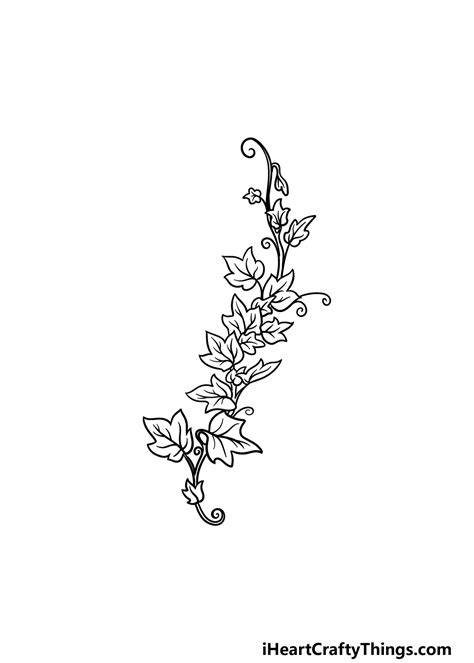Introduction

Flower vines are a beautiful and versatile subject for drawing, adding a touch of nature and elegance to any artwork. Whether you’re a beginner or an experienced artist, learning to draw flower vines can enhance your artistic skills and open up new creative possibilities. This comprehensive guide will provide step-by-step instructions, tips, and tricks to help you master the art of flower vine drawing.
Step-by-Step Instructions
Materials:
- Pencil and eraser
- Paper
- Ruler (optional)
- Coloring materials (optional)
Step 1: Sketch the Main Stems
- Draw two parallel lines to represent the main stems of your vine.
- Extend the lines slightly beyond the edges of your paper.
- Curve the lines slightly to create a natural, flowing appearance.
Step 2: Draw the Leaves
- Draw small, oval shapes along the stems, alternating sides.
- Vary the size and orientation of the leaves to add interest.
- Connect the leaves to the stems using short lines.
Step 3: Add Tendrils
- Draw thin, curved lines extending from the leaves to create tendrils.
- Tendrils help vines climb and support themselves.
Step 4: Draw the Flowers
- Draw circles or ovals to represent the flowers.
- Place the flowers along the stems and tendrils.
- Add petals to the flowers by drawing curved lines around the circles.
Step 5: Enhance the Details
- Add veins to the leaves by drawing thin lines from the center to the edges.
- Draw tiny dots or lines on the flowers to create a textured appearance.
- Use a ruler to draw straight lines for the stems if desired.
Step 6: Color and Finish
- Color the flower vines using colored pencils, markers, or paint.
- Add shadows and highlights to create depth.
- Alternatively, leave the drawing uncolored for a more minimalist effect.
Tips for Beginners
- Start with simple vine shapes and gradually add more complexity.
- Use references from photographs or nature to guide your drawing.
- Pay attention to the spacing and arrangement of the leaves and flowers.
- Experiment with different pencil weights to create shading and texture.
- Don’t be afraid to erase and redraw until you’re satisfied.
Inspiration and Applications
Creative Ideas:
- Create floral borders for invitations, greeting cards, and artwork.
- Decorate walls with vine murals to bring nature indoors.
- Design textiles and home décor featuring flower vine motifs.
Practical Applications:
- Botanical illustrations for scientific publications.
- Architectural details such as trellises and archways.
- Packaging design for natural and organic products.
Troubleshooting
Common Mistakes to Avoid:
- Drawing the stems too straight or rigid.
- Making the leaves too uniform in size and shape.
- Placing the flowers and tendrils randomly without considering the natural flow of the vine.
- Overcrowding the drawing with too many details.
Pros and Cons of Flower Vine Drawing:
Pros:
- Enhance your drawing skills and artistic expression.
- Create beautiful and versatile artwork.
- Connect with nature through botanical art.
- Develop a keen eye for detail and observation.
Cons:
- Can be time-consuming, especially for complex designs.
- May require patience and attention to detail.
- Requires practice to master the different elements of the vine.
Key Statistics:
- According to a survey conducted by the American Society of Botanical Illustrators, over 70% of botanical artists incorporate flower vines into their work.
- The global market for botanical art is estimated to reach $3 billion by 2025, indicating a growing demand for floral designs.
- Studies have shown that exposure to floral art can reduce stress and promote relaxation.
Tables for Reference
Table 1: Leaf Shapes for Flower Vines
| Leaf Shape | Examples |
|---|---|
| Oval | Jasmine, Honeysuckle |
| Heart-shaped | Clematis, Passionflower |
| Lobed | Virginia Creeper, Grape |
| Compound | Wisteria, Peas |
Table 2: Flower Types Found on Vines
| Flower Type | Examples |
|---|---|
| Bell-shaped | Honeysuckle, Columbine |
| Funnel-shaped | Morning Glory, Petunia |
| Trumpet-shaped | Trumpet Vine, Mandevilla |
| Star-shaped | Star Jasmine, Clematis |
Table 3: Tendril Types for Vines
| Tendril Type | Examples |
|---|---|
| Coiling | Virginia Creeper, Ivy |
| Spiraling | Honeysuckle, Wisteria |
| Adhesive | Climbing Hydrangea, Boston Ivy |
| Hooked | Grapes, Passionflower |
Table 4: Common Mistakes to Avoid in Flower Vine Drawing
| Mistake | Description |
|---|---|
| Rigid Stems | Drawing the stems too straight or vertical. |
| Uniform Leaves | Making the leaves too similar in size and shape. |
| Random Placement | Positioning the flowers and tendrils without considering the natural flow of the vine. |
| Overcrowding | Adding too many details or elements, resulting in a cluttered appearance. |
